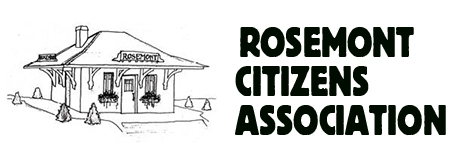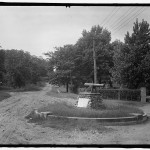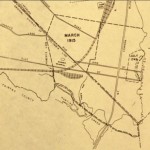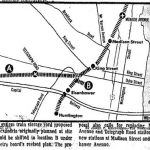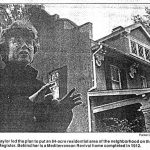Did You Know?
A series of occasional articles about the history of Rosemont.
Rosemont Street Names
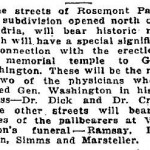 Although many of Rosemont’s streets are named after trees, when the northeast corner of Rosemont was laid out in the 1920s, the nearby George Washington Masonic Memorial was under construction, and as a result the streets were named after individuals connected with the death of George Washington. Notably, Dennis RAMSEY, Charles LITTLE, and Phillip MARSTELLER all were pallbearers at Washington’s funeral.
Although many of Rosemont’s streets are named after trees, when the northeast corner of Rosemont was laid out in the 1920s, the nearby George Washington Masonic Memorial was under construction, and as a result the streets were named after individuals connected with the death of George Washington. Notably, Dennis RAMSEY, Charles LITTLE, and Phillip MARSTELLER all were pallbearers at Washington’s funeral.
Other streets had their names changed in the late 1930s – typically, to match the names of the older streets on the other side of Commonwealth Avenue – but previously had connections with Washington, including East Masonic View Avenue (originally named after Dr. James CRAIK, Washington’s physician), East Oak Street (originally named after Dr. Elisha DICK, another physician), Wayne Street (originally named after George GILPIN, a pallbearer) and East Chapman Street (originally named after Charles SIMMS, a pallbearer).
Oronoco-Linden Underpass
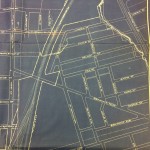 When the eastern section of Rosemont began to develop in the 1920s, residents complained that they lacked easy access to Old Town; the only official railroad crossings were at Braddock Road and on King Street (at the time, the Commonwealth Avenue underpass was only for electric trolleys). As early as 1922, they requested that a new underpass be built connecting Oronoco Street and Linden Street – and as late as 1951, there were requests for a pedestrian tunnel, to enable children to more easily and safely attend the Jefferson School. The Alexandria Library’s collection include a 1929 set of blueprints for an underpass, but the project was never authorized by City Council (and townhomes were built along Linden Street and Mount Vernon Avenue in 1940s that effectively put an end to the idea for a road linkage).
When the eastern section of Rosemont began to develop in the 1920s, residents complained that they lacked easy access to Old Town; the only official railroad crossings were at Braddock Road and on King Street (at the time, the Commonwealth Avenue underpass was only for electric trolleys). As early as 1922, they requested that a new underpass be built connecting Oronoco Street and Linden Street – and as late as 1951, there were requests for a pedestrian tunnel, to enable children to more easily and safely attend the Jefferson School. The Alexandria Library’s collection include a 1929 set of blueprints for an underpass, but the project was never authorized by City Council (and townhomes were built along Linden Street and Mount Vernon Avenue in 1940s that effectively put an end to the idea for a road linkage).
Matthew Maury
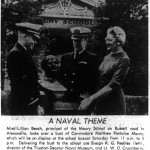 Maury Elementary School was opened in 1929 – with six classrooms and an auditorium – to serve the growing population of Rosemont and what was then referred to as the “West End” of Alexandria, replacing a small building on what are now the grounds of the Masonic Memorial. The school since has been significantly expanded, including a wing added in the late ’40s with a cafeteria and nine additional classrooms. Matthew Maury was a naval oceanographer and is known as the “Father of the Confederate Navy.” The neighboring park originally also was named after Maury, but became Beach Park in 1974 to honor Lillian Beach upon her retirement after a 22-year tenure as principal of the school. A former elementary school in Arlington (1910-1975) also was named after Maury.
Maury Elementary School was opened in 1929 – with six classrooms and an auditorium – to serve the growing population of Rosemont and what was then referred to as the “West End” of Alexandria, replacing a small building on what are now the grounds of the Masonic Memorial. The school since has been significantly expanded, including a wing added in the late ’40s with a cafeteria and nine additional classrooms. Matthew Maury was a naval oceanographer and is known as the “Father of the Confederate Navy.” The neighboring park originally also was named after Maury, but became Beach Park in 1974 to honor Lillian Beach upon her retirement after a 22-year tenure as principal of the school. A former elementary school in Arlington (1910-1975) also was named after Maury.
Rosemont Station
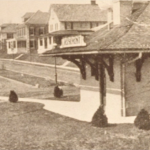 The RCA logo is rendering of Rosemont Station, which was the primary stop in the neighborhood for the electric trolleys which ran through the neighborhood until 1932.
The RCA logo is rendering of Rosemont Station, which was the primary stop in the neighborhood for the electric trolleys which ran through the neighborhood until 1932.
The Washington, Alexandria, and Mount Vernon Railway at its peak ran from Fort Belvoir to a terminal near the current Federal Triangle Metro station. The line actually predated Rosemont, but the station was built in 1909 on an island at what is now the intersection of Commonwealth Avenue (then called Washington Avenue) and Rosemont Avenue; the curved sidewalks on the west side of the intersection are a remnant of the original traffic pattern.
The Post described the plans for the station thusly: “The building will be entirely of concrete, with the exception of the roof, which will be shingled. The roof will overhang from the face of the building and will be supported by ornamental brackets. The windows will be of the French casement type, and will be glazed with diamond-shaped panes. The waiting room will be heated by electricity.”
The station served as a focal point for the neighborhood in its early years, and hosted a police sub-station as well as meetings of the first incarnation of the Rosemont Citizens Association, which was founded in 1913. The original Rosemont tennis courts were located opposite the station on the east side of Commonwealth Avenue. The station also served as the polling place for Rosemont between 1929 and 1937.
The exact date of its demolition is presently unknown, but appears to have been around 1938, in connection with work to remove the trolley tracks and widen Commonwealth Avenue to its present configuration.
Rosemont Retail – Commonwealth and Walnut
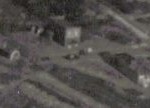 Although the Grape + Bean is today the only retail establishment in the heart of Rosemont, the intersection of Commonwealth Avenue and Walnut Street historically was home to several shops. Before the Grape + Bean, the Rosemont Park Market occupied 2 East Walnut Street for more than 80 years.
Although the Grape + Bean is today the only retail establishment in the heart of Rosemont, the intersection of Commonwealth Avenue and Walnut Street historically was home to several shops. Before the Grape + Bean, the Rosemont Park Market occupied 2 East Walnut Street for more than 80 years.
Across the street at 1 East Walnut Street was another commercial building, in use as early as 1921 and known to have been occupied by a grocery store in the ’30s; a pharmacy from the ’40s through the early ’60s; a real estate office in the mid-’60s; and a bank from 1968 through 1993. The back side of the building, numbered as 405 Commonwealth Avenue, housed a beauty salon from the ’40s through the ’60s. The building subsequently was demolished and replaced by townhomes in the late ’90s.
And in the middle of Commonwealth Avenue at Walnut Street was North Rosemont Station, built in 1913 – one of three trolley stops in Rosemont. As early as 1928, a branch of the Sanitary Grocery Store (a local chain later acquired by Safeway) was operating out of the station; in 1938, the City condemned the property in order to remove the trolley tracks and widen Commonwealth Avenue (the last train had run in 1932).
A photo from 1930, shows all three buildings (and is the only currently known image of North Rosemont Station – not to be confused with the more historic and better documented trolley station at the intersection of Commonwealth Avenue and Rosemont Avenue).
Rosemont Pre-History
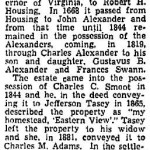 Although the development of Rosemont started in 1908, there are about a half-dozen houses in the neighborhood of earlier pedigree – primarily on or near King Street, which was the historic “Leesburg Turnpike.”
Although the development of Rosemont started in 1908, there are about a half-dozen houses in the neighborhood of earlier pedigree – primarily on or near King Street, which was the historic “Leesburg Turnpike.”
403 West Masonic View Avenue was built about 1850 and long was the farmhouse of the Hohenstein family; it can be seen on an 1862 Civil War map.
2525 King Street was built about 1819 and is known as “Eastern View”; see attached for a history of the house and property which was provided in connection with an open house in 1938, when it was already historic.
Rosemont Churches
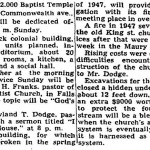 Although Rosemont is largely residential, it includes several houses of worship. The gallery on the RCA website includes some historical images of the Commonwealth Baptist Church at 700 Commonwealth Avenue and the Alexandria Church of Christ at 111 East Braddock (http://www.rosemontcitizensassoc.org/gallery/), both built in the late ’40s.
Although Rosemont is largely residential, it includes several houses of worship. The gallery on the RCA website includes some historical images of the Commonwealth Baptist Church at 700 Commonwealth Avenue and the Alexandria Church of Christ at 111 East Braddock (http://www.rosemontcitizensassoc.org/gallery/), both built in the late ’40s.
But the first church in Rosemont was located near the corner of Commonwealth Avenue and East Oak Street (then known as Washington Avenue and Dick Street, respectively), built by the Seventh Day Adventists in the early 1930s. That congregation later moved to 1400 Russell Road, and the Oak Street building since has been used by several different congregations; it is currently the Redeemed Church of Christ.
Rosemont during World War II
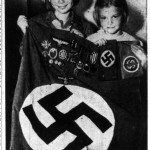 Like all of the U.S., Rosemont was affected by World War II. Newspapers regularly reported on the status of soldiers, as well as the home front; the November 15, 1944 edition of the Post reported that for a paper salvage drive sponsored by the Alexandria Junior Chamber of Commerce, “the most effective collections were made in the Rosemont neighborhood.”
Like all of the U.S., Rosemont was affected by World War II. Newspapers regularly reported on the status of soldiers, as well as the home front; the November 15, 1944 edition of the Post reported that for a paper salvage drive sponsored by the Alexandria Junior Chamber of Commerce, “the most effective collections were made in the Rosemont neighborhood.”
A few days before V-J Day, the children’s page of the Star ran the attached photo, showing the war trophies brought home by Owen Cox, held by his daughters Jean and Janice (perhaps not fully realizing the symbolism of the items displayed).
Hooff’s Run
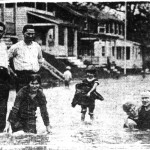 Hooff’s Run is one of the major geographic features of Rosemont, even though it is now mostly hidden from view. In the early 19th century it was reportedly navigable, but by the time Rosemont began to develop it was better known as a source of flooding – and sometimes as an open drain. Once East Rosemont developed in the 1920s, Hooff’s Run was culverted and a separate sewer installed, and complaints became less common – but flooding remained and remains an issue. This photo shows an inundated East Linden Street in 1922.
Hooff’s Run is one of the major geographic features of Rosemont, even though it is now mostly hidden from view. In the early 19th century it was reportedly navigable, but by the time Rosemont began to develop it was better known as a source of flooding – and sometimes as an open drain. Once East Rosemont developed in the 1920s, Hooff’s Run was culverted and a separate sewer installed, and complaints became less common – but flooding remained and remains an issue. This photo shows an inundated East Linden Street in 1922.
Rosemont Alumni – Willard Scott
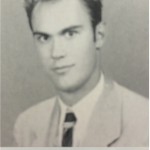 Rosemont’s “famous son” is television personality – and original Ronald McDonald – Willard Scott, who grew up at 125 Commonwealth Avenue in the 1940s and was president of the George Washington High School class of 1951.
Rosemont’s “famous son” is television personality – and original Ronald McDonald – Willard Scott, who grew up at 125 Commonwealth Avenue in the 1940s and was president of the George Washington High School class of 1951.
Rosemont Retail – Braddock and Mount Vernon
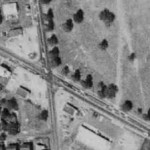 One of the commercial areas in Rosemont is the intersection of Braddock Road and Mount Vernon Avenue. The southeast side, recently developed as Yates Corner, previously was a strip mall; tenants had included a 7-Eleven since the early 1960s. and a Subway since the early 1980s. Pauline Rose operated the Silver Shears salon for 40 years until she retired in 2007.
One of the commercial areas in Rosemont is the intersection of Braddock Road and Mount Vernon Avenue. The southeast side, recently developed as Yates Corner, previously was a strip mall; tenants had included a 7-Eleven since the early 1960s. and a Subway since the early 1980s. Pauline Rose operated the Silver Shears salon for 40 years until she retired in 2007.
Along the Mount Vernon Avenue side of the property, there was a service station between the 1950s and 1980s, and a building which housed the offices of a baby photo studio in the 1970s and from which Kaufmann Office Equipment later sold typewriters until the 1990s.
Across the street, the Yates family have operated Yates Automotive since 1964, but there has been a service station on the site since the early 1940s.
Historically, the northwest corner also was a commercial area, including another service station and the first Burger Chef in the region, which opened in 1959. Later, it was the site of Artifacts, which sold “architectural antiques,” before the property was redeveloped as townhomes in the 1990s.
And Braddock Fields (recently renamed for Lenny Harris), which today provides open space for George Washington Middle School and the neighborhood, previously was the site of the greenhouses for florists – initially Guckert & Beck, and then the Alexandria Floral Company – from the 1920s until the 1940s. The attached aerial photo shows the area in 1964.
Rosemont Retail – Mount Vernon Avenue
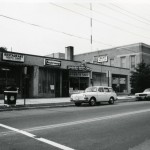 The stores at 1302 – 1310 Mount Vernon Avenue are at the northern edge of what could be considered to be Rosemont (Alexandria’s neighborhood boundaries are unofficial, and Del Ray also stakes a claim).
The stores at 1302 – 1310 Mount Vernon Avenue are at the northern edge of what could be considered to be Rosemont (Alexandria’s neighborhood boundaries are unofficial, and Del Ray also stakes a claim).
The building was built in the early 1950s, and currently is occupied by two restaurants, a dry cleaner, a barber shop, and a hair salon. Previous tenants included a bakery/delicatessen, a rug store, a yoga studio, a massage parlor, a youth counseling center, and a car stereo shop.
The tenant with the longest pedigree is the South China Restaurant, which has been there since the early 1970s, replacing the Sugar Bowl variety store (the attached photo is from 1976).
Rosemont Street Names and Numbers
Russell Road and Commonwealth Avenue – the primary north-south arteries through Rosemont – both originally were known by different names. Commonwealth Avenue started out as Washington Avenue; the name was changed in the early 1940s to avoid confusion with Washington Street in Old Town. The segment of Russell Road that runs through Rosemont briefly was known as Mount Vernon Boulevard; it was hoped that the street would be chosen as the route to the Mount Vernon estate, but that did not occur and the name was changed by the 1920s to avoid confusion with the Mount Vernon Avenue in Del Ray (which itself was later was extended into East Rosemont).
Additionally, in 1938 there was a mass renumbering of houses in Alexandria, to establish a uniform system; in Rosemont, numbers increase by block running east and west from what was then Washington Avenue. The 1941 Sanborn insurance maps (excerpts from which are available from the Gallery on the RCA website) list both sets of numbers, which can be useful in performing historical research.
Rosemont Alumni – Guy Gardner
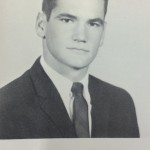 Astronaut Guy Gardner (who piloted Space Shuttle missions in 1988 and 1990) primarily grew up at 409 Rucker Place, and attended both Maury Elementary School and George Washington High School.
Astronaut Guy Gardner (who piloted Space Shuttle missions in 1988 and 1990) primarily grew up at 409 Rucker Place, and attended both Maury Elementary School and George Washington High School.
Rosemont Alumni – Chip Esten
Actor Charles “Chip” Esten (of “Nashville” and “Whose Line Is It Anyway?”) lived on North View Terrace from age 8, and attended Maury Elementary School. In a 2013 interview with the Alexandria Gazette-Packet, he recalled winning a third-grade song-rewriting contest by changing the words of “It’s a Small World (after All)” to “It’s a great school after all.”
Rosemont Alumni – Dermot Mulroney
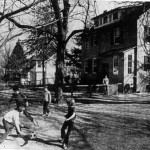 In the late 1980s, Dermot Mulroney was a new face in Hollywood, compared by a Washington Post article to Tom Cruise and Tom Hanks. Although Mulroney never made the “A-List” he appeared in films such as “Young Guns” and recently appeared in the NBC series “Crisis.” He also grew up in Rosemont – and was pictured in a 1974 Washington Star article about the neighborhood well before he was famous (in the backyard of 207 North View Terrace).
In the late 1980s, Dermot Mulroney was a new face in Hollywood, compared by a Washington Post article to Tom Cruise and Tom Hanks. Although Mulroney never made the “A-List” he appeared in films such as “Young Guns” and recently appeared in the NBC series “Crisis.” He also grew up in Rosemont – and was pictured in a 1974 Washington Star article about the neighborhood well before he was famous (in the backyard of 207 North View Terrace).
Tennis, Anyone?
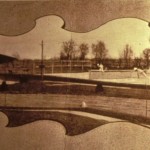 The tennis court at the corner of East Oak Street and Marsteller Street was built in the late 1970s, after the property was acquired as a park from the owners of the Rosemont Park Market (the predecessor to the Grape + Bean). But two tennis courts previously existed on the east side of Commonwealth Avenue, at the intersection with Rosemont Avenue. The first court was completed by the spring of 1912, and featured in a pamphlet publicizing Rosemont; the second was completed in the spring of 1914. The courts disappeared circa 1940, when East Rosemont Avenue was constructed.
The tennis court at the corner of East Oak Street and Marsteller Street was built in the late 1970s, after the property was acquired as a park from the owners of the Rosemont Park Market (the predecessor to the Grape + Bean). But two tennis courts previously existed on the east side of Commonwealth Avenue, at the intersection with Rosemont Avenue. The first court was completed by the spring of 1912, and featured in a pamphlet publicizing Rosemont; the second was completed in the spring of 1914. The courts disappeared circa 1940, when East Rosemont Avenue was constructed.
Fourth of July
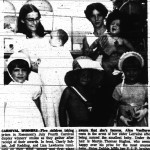 The annual Rosemont tradition of a Fourth of July celebration (unfortunately, suspended this year due to construction plans for the schoolyard) at the Maury School began about fifty years ago – the first clipping in our files is from 1967 (and the first photo from 1968), although we’re not sure that was actually the first year for the event.
The annual Rosemont tradition of a Fourth of July celebration (unfortunately, suspended this year due to construction plans for the schoolyard) at the Maury School began about fifty years ago – the first clipping in our files is from 1967 (and the first photo from 1968), although we’re not sure that was actually the first year for the event.
Rosemont Alumni – Howard K. Smith
A past resident of Rosemont (at 204 West Walnut Street) was Congressman Howard W. Smith, who represented Virginia’s 8th district in the House of Representatives between 1931 and 1967, and chaired the rules committee between 1955 and 1967. His legacy is mixed – although an early advocate of women’s rights, his views on racial issues might politely be described as unenlightened, and his opposition to the Civil Rights Act of 1964 led to his defeat in the 1966 Democratic primary. He continued to live in Rosemont until his death in 1976.
Rosemont Park Market
 One of the first – and certainly the longest-lasting – business in Rosemont was the Rosemont Park Market. A grocery store was operating at 2 East Walnut Street under that name as early as 1930. In 1943, Vivian Burke, the daughter of the proprietor at the time, was reported to have received a four-year scholarship to GWU. By the 1950s, it was affiliated with District Grocery Stores, a local cooperative – and through the mid-1970s its proprietors were Seymour and Frances Fromm. They were later followed by Albert and Maria Chung, before the store was converted to the Grape + Bean in 2012.
One of the first – and certainly the longest-lasting – business in Rosemont was the Rosemont Park Market. A grocery store was operating at 2 East Walnut Street under that name as early as 1930. In 1943, Vivian Burke, the daughter of the proprietor at the time, was reported to have received a four-year scholarship to GWU. By the 1950s, it was affiliated with District Grocery Stores, a local cooperative – and through the mid-1970s its proprietors were Seymour and Frances Fromm. They were later followed by Albert and Maria Chung, before the store was converted to the Grape + Bean in 2012.
Practical Jokes
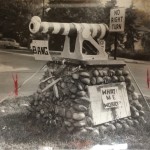 Rosemont probably would not be described as Alexandria’s wackiest neighborhood, but local jokesters have made the papers on at least two occasions.
Rosemont probably would not be described as Alexandria’s wackiest neighborhood, but local jokesters have made the papers on at least two occasions.
The August 22, 1959 edition of the Daily News reported that the cannon at the intersection of Braddock Road and Russell Road “has become the target of pranksters who festoon and paint it. Yesterday the cannon was painted pink and white, decorated with balloons, and had inane signs hung on it.”
The December 23, 1976 edition of the Post reported that Alexandria City Manager Douglas Harman had received as a gag gift from City employees a demolished and worthless Cadillac, which was towed to his driveway on North View Terrace from a local junkyard.
Aviation in Rosemont
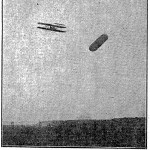 Although Rosemont is located close to National Airport, “aviation” might not be the first word that comes to mind when one thinks of the neighborhood. But Rosemont’s earliest days witnessed at least two aviation milestones. On July 30, 1909, Orville Wright made a demonstration flight for the Army from Fort Myer to Shooter’s Hill (today the site of the George Washington Masonic Memorial) and back, the route of which passed over Rosemont. Based on the success of this flight, the Army accepted it as the world’s first military aircraft. Additionally, an article in the August 11, 1911 edition of the Washington Herald reported that Tony Janus – an aviation pioneer – was expected to make a trial flight of a new monoplane from one of the fields adjacent to Rosemont.
Although Rosemont is located close to National Airport, “aviation” might not be the first word that comes to mind when one thinks of the neighborhood. But Rosemont’s earliest days witnessed at least two aviation milestones. On July 30, 1909, Orville Wright made a demonstration flight for the Army from Fort Myer to Shooter’s Hill (today the site of the George Washington Masonic Memorial) and back, the route of which passed over Rosemont. Based on the success of this flight, the Army accepted it as the world’s first military aircraft. Additionally, an article in the August 11, 1911 edition of the Washington Herald reported that Tony Janus – an aviation pioneer – was expected to make a trial flight of a new monoplane from one of the fields adjacent to Rosemont.
Rosemont’s Philadelphia Origins
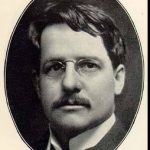 Rosemont’s early history is linked to Philadelphia. Many of the board members of the Rosemont Development Company had links to the Washington & Mount Vernon Railway, which ran trolleys through Rosemont and was owned by Philadelphia-based investors. Early media reports about Rosemont noted that Philadelphia-based contractors were building houses, some of them designed by David Knickerbacker Boyd of Philadelphia (pictured below). Likewise, Rosemont was generally said to have been modeled on the Philadelphia suburb of Wayne – home of Frederic H. Teat, the President of the RDC c. 1911-17.
Rosemont’s early history is linked to Philadelphia. Many of the board members of the Rosemont Development Company had links to the Washington & Mount Vernon Railway, which ran trolleys through Rosemont and was owned by Philadelphia-based investors. Early media reports about Rosemont noted that Philadelphia-based contractors were building houses, some of them designed by David Knickerbacker Boyd of Philadelphia (pictured below). Likewise, Rosemont was generally said to have been modeled on the Philadelphia suburb of Wayne – home of Frederic H. Teat, the President of the RDC c. 1911-17.
Rosemont Alumni – Casey Wilson
Comedian Casey Wilson – who appeared on Saturday Night Live and subsequently in various TV shows and movies – grew up in Rosemont.
Rosemont Alumni – John F. Hunter
One of Rosemont’s notable – but little-remembered – residents was John F. Hunter, who represented the 9th District of Ohio in Congress between 1937 and 1943. After leaving Congress, he practiced law and starting in 1952 lived at 14 West Oak Street. In 1953, he was appointed as one of Alexandria’s two representatives on the Virginia National Capital Park Authority. Hunter passed away in 1957.
Virginia Shipbuilding Company
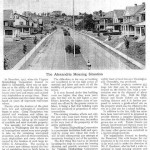 During World War I, the Virginia Shipbuilding Company built a facility at Jones Point to build merchant ships (10 being delivered before operations shut down in 1920) – and purchased 162 lots in Rosemont in the spring of 1918, to build houses for its employees. In 1920, it emerged that the company had diverted $400,000 paid to it by the federal government for ship construction to house construction, and a federal investigation followed, which contributed to the collapse of the company.
During World War I, the Virginia Shipbuilding Company built a facility at Jones Point to build merchant ships (10 being delivered before operations shut down in 1920) – and purchased 162 lots in Rosemont in the spring of 1918, to build houses for its employees. In 1920, it emerged that the company had diverted $400,000 paid to it by the federal government for ship construction to house construction, and a federal investigation followed, which contributed to the collapse of the company.
West End School
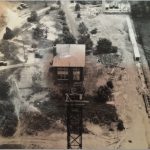 Before Maury Elementary School was opened in 1929, children from Rosemont attended school in a small building on the south side of Shooter’s Hill (near the later-built maintenance building for the George Washington Masonic Memorial, visible from Duke Street). The school was referred to as the “West End School”; although “West End” now has a different meaning in Alexandria, since the late 18th century the area just outside the colonial-era boundaries of Alexandria had been known by that name, and hosted businesses such as butchers and millers that were not desired within the city. The West End School was used as an overflow facility for a few years after Maury was built, but was demolished by the early 1930s.
Before Maury Elementary School was opened in 1929, children from Rosemont attended school in a small building on the south side of Shooter’s Hill (near the later-built maintenance building for the George Washington Masonic Memorial, visible from Duke Street). The school was referred to as the “West End School”; although “West End” now has a different meaning in Alexandria, since the late 18th century the area just outside the colonial-era boundaries of Alexandria had been known by that name, and hosted businesses such as butchers and millers that were not desired within the city. The West End School was used as an overflow facility for a few years after Maury was built, but was demolished by the early 1930s.
Boundary Stone
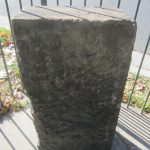 Although the original stone disappeared in the 19th century, Rosemont is home to one of the 40 boundary stones marking the original borders of the District of Columbia (in 1846, the Virginia side was retroceded to Virginia). The current stone was dedicated by the Daughters of the American Revolution in the 1920s.
Although the original stone disappeared in the 19th century, Rosemont is home to one of the 40 boundary stones marking the original borders of the District of Columbia (in 1846, the Virginia side was retroceded to Virginia). The current stone was dedicated by the Daughters of the American Revolution in the 1920s.
The cannon mounted at the intersection of Braddock Road and Russell Road was left behind by General Braddock in 1755, on an ill-fated mission at the start of the French and Indian War in which he was killed but a young officer named George Washington rose to prominence. In 1915, the cannon was erected by the Society of Colonial Dames to mark the route which his expedition took from Alexandria.
Annexation
When the development of Rosemont began, it was part of Arlington County (which was itself known as Alexandria County until 1920). In 1915, Alexandria annexed Rosemont along with other territory then known as the “west end”; at the time Rosemont was described to be generally supportive of annexation, since its residents “attend the churches, places of amusement, participate in the social life of the city, and are practically, as closely connected with the city life as are the people residing within the city’s boundaries.”
Streetcar Suburb
Rosemont was originally developed as a “streetcar suburb,” along a trolley line thats served Washington, DC, with stops along Commonwealth Avenue at King Street, Rosemont Avenue, Walnut Street, and Braddock Road. The trolley service ended in 1932, but mass rail transit returned to the neighborhood in 1983 with the opening of the King Street and Braddock Road Metro stations.
Maury Elementary
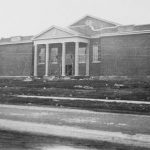 Originally, children from Rosemont attended a small school located on what are now the grounds of the George Washington National Masonic Memorial. The construction of the memorial – and the growing population of Rosemont – resulted in demands for a new school starting as early as 1924, and after several false starts construction began in June 1928 by Farmville Manufacturing, inc., which had bid $49,115 for the project. The school was formally dedicated on March 13, 1929.
Originally, children from Rosemont attended a small school located on what are now the grounds of the George Washington National Masonic Memorial. The construction of the memorial – and the growing population of Rosemont – resulted in demands for a new school starting as early as 1924, and after several false starts construction began in June 1928 by Farmville Manufacturing, inc., which had bid $49,115 for the project. The school was formally dedicated on March 13, 1929.
Historic District
The historic core of Rosemont has been listed on the National Register of Historic Places since 1992, as a well-preserved early 20th century streetcar suburb. The underlying application is available at http://
